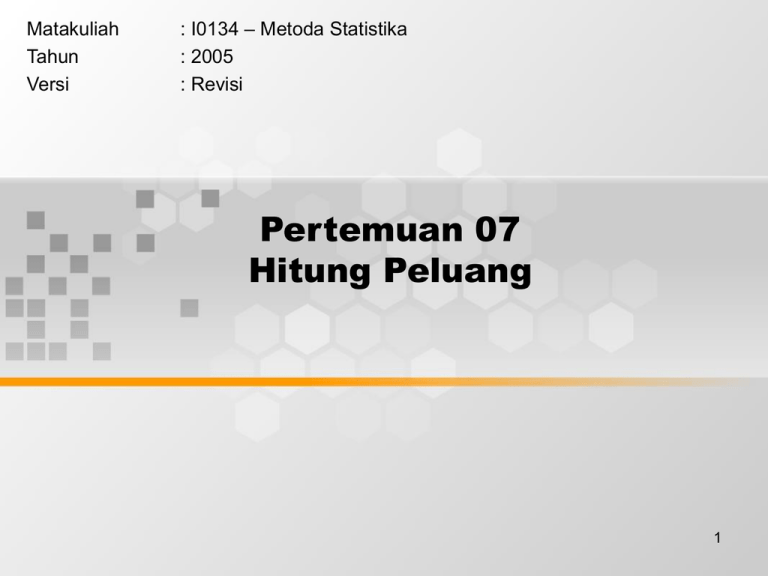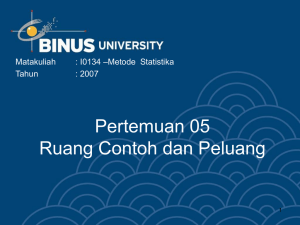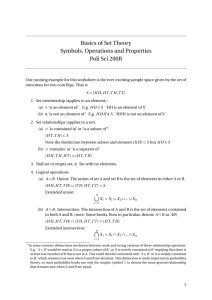Pertemuan 07 Hitung Peluang – Metoda Statistika Matakuliah
advertisement

Matakuliah Tahun Versi : I0134 – Metoda Statistika : 2005 : Revisi Pertemuan 07 Hitung Peluang 1 Learning Outcomes Pada akhir pertemuan ini, diharapkan mahasiswa akan mampu : • Mahasiswa dapat menghitung dan menyusun sebaran peluang kejadian. 2 Outline Materi • • • • Ruang contoh dan Peluang kejadian Kejadian gabungan dan irisan Kejadian komplementasi Kaidah Penghitungan 3 Probability is: A measure of uncertainty A measure of the strength of belief in the occurrence of an uncertain event A measure of the degree of chance or likelihood of occurrence of an uncertain event Measured by a number between 0 and 1 (or between 0% and 100%) 4 Types of Probability Objective or Classical Probability – based on equally-likely events – based on long-run relative frequency of events – not based on personal beliefs – is the same for all observers (objective) – examples: toss a coins, throw a die, pick a card 5 Types of Probability (2) Subjective Probability – based on personal beliefs, experiences, prejudices, intuition - personal judgment – different for all observers (subjective) – examples: Super Bowl, elections, new product introduction, snowfall 6 Basic Definitions Set - a collection of elements or objects of interest – Empty set (denoted by ) a set containing no elements – Universal set (denoted by S) a set containing all possible elements – Complement (Not). The complement of A is – a set containing all elements of S not in A A 7 Basic Definitions –Intersection (And) – A B a set containing all elements in both A and B –Union (Or) – A B a set containing all elements in A or B or both 8 Basic Definitions • Mutually exclusive or disjoint sets –sets having no elements in common, having no intersection, whose intersection is the empty set • Partition –a collection of mutually exclusive sets which together include all possible elements, whose union is the universal set 9 Sets: Diagrams A A A B B B A A A B A B A3 A1 A2 A4 A5 Partition 10 Experiment • Process that leads to one of several possible outcomes *, e.g.: – Coin toss • Heads,Tails – Throw die • 1, 2, 3, 4, 5, 6 – Pick a card • AH, KH, QH, ... • • – Introduce a new product Each trial of an experiment has a single observed outcome. The precise outcome of a random experiment is unknown before a trial. * Also called a basic outcome, elementary event, or simple event 11 Events : Definition Sample Space or Event Set – Set of all possible outcomes (universal set) for a given experiment E.g.: Throw die – S = (1,2,3,4,5,6) Event – Collection of outcomes having a common characteristic E.g.: Even number – A = (2,4,6) – Event A occurs if an outcome in the set A occurs Probability of an event – Sum of the probabilities of the outcomes of which it consists P(A) = P(2) + P(4) + P(6) 12 Equally-likely Probabilities (Hypothetical or Ideal Experiments) • For example: – Throw a die • Six possible outcomes (1,2,3,4,5,6) • If each is equally-likely, the probability of each is 1/6 = .1667 = 16.67% 1 P ( e) • n( S ) • Probability of each equally-likely outcome is 1 over the number of possible outcomes – Event A (even number) • P(A) = P(2) + P(4) + P(6) = 1/6 + 1/6 + 1/6 = 1/2 • P( A) P( e) for e in A n( A ) 3 1 n( S ) 6 2 13 Basic Rules for Probability Range of Values 0 P( A) 1 Complements - Probability of not A P( A ) 1 P( A) Intersection - Probability of both A and B P( A B) n( A B) n( S ) – Mutually exclusive events (A and C) : P( A C ) 0 14 • Selamat Belajar Semoga Sukses. 15

